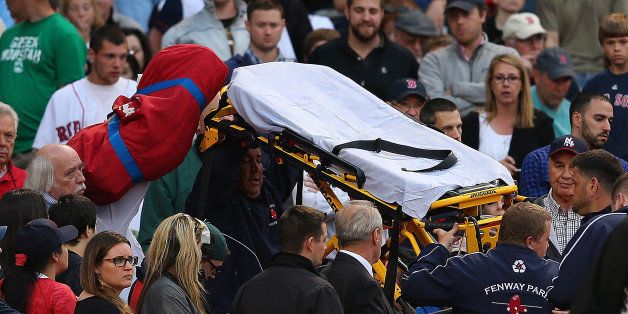
During the second inning of the night game at Fenway Park on June 5, 2015, between the Boston Red Sox and the Oakland Athletics, Brett Lawrie, the A's third baseman, splintered his bat when grounding out to Dustin Pedroia, the Sox second baseman. It was a common play in all instances except one -- a piece of Lowrie's bat struck a fan, Tonya Carpenter, sitting in the second row on the third base side of the diamond. The game was stopped while Carpenter, bleeding profusely from the head, was rushed out of the stadium to the hospital.
The incident became national, and even international, news. It remains a front page story in the Boston Globe. At every baseball game, around 30 or more foul balls travel into the stands. Fans lunge to catch these flying "treasures," oblivious to the risks involved in catching what amounts to a rock traveling at great speed. Increasingly, splintered chards from bats have followed the same path, although not with the same frequency.
The media has correctly reported that a spectator at a baseball game has little or no chance of recovering damages from the stadium for her injuries. Fenway Park is adorned with cautionary signs: "Foul balls and bats hurt." In case anyone had any doubt, the back of the ticket of admission to the game in tiny print states that the team and the stadium are not be liable for any injuries caused by flying implements of the game.
Normally, a potential defendant cannot disclaim liability simply by printing an exculpatory clause on the back of a ticket, but courts have long favored professional sports in litigation involving cases like Ms. Carpenter's. In fact, holding such potential defendants harmless is so common that it has earned a distinctive formulation: The Baseball Rule.
For decades, court opinions have reasoned that anyone who attends a baseball game will be held to appreciate the nature of the dangers involved. Employing the defense known as "assumption of risk," courts stated that patrons subjectively know that balls (the most common object involved) and bats fly into the stands and can cause grievous injury. Why would a spectator subject himself or herself to such danger? It is part of the ambience of attending a game. What if a spectator does not wish to accept that risk? Courts say, quoting Justice Cardozo, "the timorous may stay at home."
As the doctrine of assumption of risk has fallen out of favor, courts refocused their attention on whether a stadium has breached "a duty" to the fallen spectator. We owe to each other a duty of "ordinary care," and, if we fail to meet that standard (and as a result cause injury to another), our negligence is actionable. Did the Red Sox breach a duty it owed to Ms. Carpenter, who was, after all, a "business invitee" to Fenway Park?
Fenway Park had a duty to exercise ordinary prudence regarding the safety of its patrons. With regard to flying objects, it was required to screen in a portion of the seating area behind home plate. The risks of injury determine the "burden of safeguarding." If fans are injured every time a ball or bat flies into the stands, a reasonably prudent ballpark owner would extend the screening. Although it is no solace to Ms. Carpenter, her serious game-stopping injury became news because it was so rare.
In a case that reached the Massachusetts Appeals Court in 2004, a spectator, Jane Costa, who was injured by a foul ball at Fenway, sued for damages. She claimed to have never attended a game before and was totally ignorant of the risks involved in the sport. Justice Cynthia Cohen denied her claim. The dangers would be "obvious to persons of average intelligence." The plaintiff would have to bear the costs of her own injuries.
In the last paragraph of her opinion, Justice Cohen offers a "more gracious approach" to this recurring problem. Major League Baseball should "internalize the costs of unavoidable injuries sustained by fans through no fault of their own." Justice Cohen does not suggest how that can be accomplished, but it would be quite easily accomplished. If each club were to raise ticket prices by a slight amount, each spectator would be covered by the insurance that increment would purchase. Ms. Carpenter's medical expenses and lost income, if any, would be covered. There is no acceptable reason why baseball should not do this.
The best way to avoid the inevitable injuries caused by attending a game is, of course, to pay attention to what is happening on the field of play. The attack of an errant ball or bat can come at any time. When someone decides to "take [you] out to the ballgame" and buy you some "peanuts and Cracker Jack," make sure you have at least one eye on the batter.